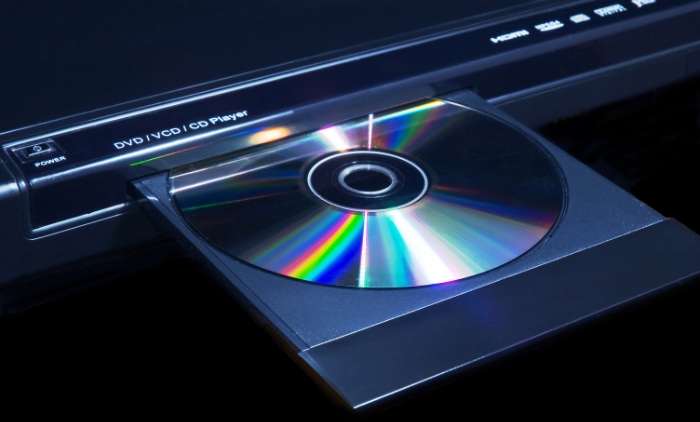VHS vs. DVD: How Each Shaped Our Viewing Experience

From Betamax to streaming services, the landscape of home entertainment has seen seismic shifts over the years. Yet, two formats have left an indelible mark on the way we consume media—VHS (Video Home System) and DVD (Digital Versatile Disc).
Each became a household name for different reasons and during distinct eras.
Technological Specifications
When it comes to VHS and DVD, the nuts and bolts of their technology often dictate user experience, performance, and overall quality. Distinct differences in their technological specifications offer insights into their respective strengths and weaknesses.
The Anatomy of a VHS Tape
VHS operates on an analog magnetic tape system. The tape inside a VHS cassette is coated with a ferric oxide material, allowing it to store video and audio signals as magnetic patterns.
The tape is pulled across video and audio heads in the VHS player, translating these magnetic patterns into electrical signals that your television then converts into sound and pictures. VHS tapes typically have a storage capacity that ranges from 120 to 160 minutes, although longer tapes are available.
The Digital Disc Revolution of DVD
DVDs represent a leap into the digital age, storing data in the form of tiny pits and lands on a reflective layer within the disc. A laser reads these microscopic pits and lands, converting them into a stream of binary data.
This digital method allows DVDs to offer superior video and audio quality compared to VHS tapes. Standard DVDs can store up to 4.7 GB of data, which roughly translates to two hours of high-quality video and audio, while dual-layer DVDs can store up to 9 GB.
Storage Capacity Compared
One of the most significant technological differences between the two formats is storage capacity. While a VHS tape holds video and audio data in analog form, its storage potential is limited by the physical length of the tape.
On the other hand, DVDs, with their digital storage capability, can not only hold more data but also offer better compression algorithms, enabling higher quality media in a smaller physical space.
Longevity and Data Retrieval
The magnetic material on a VHS tape is susceptible to degradation over time, causing a loss in video and audio quality. On the flip side, DVDs are less prone to such degradation, provided they are stored properly.
However, DVDs are not entirely immune to issues like scratching, which can make them unreadable. The laser-and-pit method of data retrieval in DVDs is generally more stable and reliable compared to the magnetic tape reading in VHS.
Speed and Efficiency
VHS tapes require rewinding and fast-forwarding, which can be both time-consuming and taxing on the tape and player mechanisms. DVDs offer a more efficient experience, allowing for quick scene selections, skipping, and more, thanks to their random access capabilities.
Video and Audio Quality
A significant part of the consumer choice between VHS and DVD boils down to the perceived quality of video and audio. Both formats offer distinct characteristics that influenced not just the viewing experience but also their respective market successes.
VHS Quality Parameters
VHS operates on an analog format, which results in a lower resolution compared to digital DVDs. Standard VHS offers a video resolution of around 240 horizontal lines, which by today’s standards is considerably low.
The color depth is also limited due to the analog nature of the tape. Audio is typically mono or linear stereo, falling short of the digital surround sound capabilities found in DVDs.
Over time, the quality of a VHS tape can degrade, leading to issues such as tracking problems, audio noise, and faded colors.
DVD Quality Metrics
DVDs significantly up the ante when it comes to video and audio quality. They offer a standard resolution of 720×480 pixels (for NTSC systems) or 720×576 pixels (for PAL systems).
This leads to a much clearer and sharper image. Additionally, DVDs support various audio formats, including Dolby Digital and DTS, which enable multi-channel surround sound.
The digital nature of DVDs ensures that they are less susceptible to quality degradation over time, provided they are handled and stored correctly.
Resolution Comparison
One of the most glaring differences between VHS and DVD is the video resolution. DVDs offer about three times the resolution of VHS, making for a visibly clearer and more detailed picture.
While VHS resolution may be sufficient for smaller screens, it becomes increasingly evident on larger displays where DVDs clearly have the upper hand.
Audio Capabilities
DVDs offer far superior audio capabilities, supporting up to 5.1 channels of discrete audio for surround sound systems.
In contrast, VHS usually provides only mono or basic stereo audio. This difference is especially noticeable in media where sound plays a crucial role, such as musicals or action movies.
Impact of Quality on Genre
The quality offered by each format also had an impact on what genres were popularly consumed. For example, action films and musicals, which benefit from higher video and audio quality, were more enjoyable on DVD.
On the other hand, older TV shows and movies that were initially recorded in lower quality didn’t gain as much from the DVD format.
Usability and Convenience

When it comes to the user experience, both VHS and DVD offer unique advantages and drawbacks. From the mechanics of operating players to the ease of accessing specific content, usability and convenience played an integral role in the consumer’s choice between these two formats.
Operation of VHS Players
Operating a VHS player is a fairly straightforward process but does involve some mechanical interactions. Users must insert a VHS tape into the player, which sometimes requires additional steps like rewinding or fast-forwarding to get to the desired section of the tape.
This process can be cumbersome, especially when trying to locate a specific scene. Additionally, tapes must be rewound after viewing, adding an extra layer of inconvenience.
DVD Player User Experience
DVD players offer a more streamlined user experience. The disc is simply inserted into the player, and an interactive menu usually appears on the screen.
This menu allows for quick navigation to different chapters, special features, and settings. Because DVDs use a random-access storage method, jumping between scenes or skipping ahead is generally faster and more precise compared to VHS.
Portability and Storage
VHS cassettes are bulkier and heavier than DVDs, which are compact and easier to store. A standard VHS tape measures about 7.5 inches in width, 4 inches in depth, and 1 inch in height, taking up considerable shelf space.
DVDs, in contrast, are only about 4.7 inches in diameter and can be stored in slim cases. This makes DVDs more portable and less cumbersome to manage in a collection.
Flexibility of Content Access
DVDs offer additional functionalities like subtitles, language options, and bonus features, which can usually be accessed directly from the main menu. VHS tapes lack these interactive features, and any additional content like interviews or trailers would have to be included as separate segments on the tape itself, requiring manual fast-forwarding or rewinding to access.
Energy Consumption
While not often considered, the energy usage of these players is also worth noting. VHS players generally consume more energy due to the mechanical parts needed to read the tape.
DVD players, being mostly electronic with fewer moving parts, are typically more energy-efficient.
Cultural Impact and Legacy
Both VHS and DVD have left indelible marks on the cultural landscape, each in its own unique way. While technological specifications and user experience are vital aspects to consider, the cultural impact and enduring legacy of these formats are just as significant.
The Home Movie Experience with VHS
VHS made a groundbreaking contribution by making it possible for people to watch movies at home on their schedule, a feat that cannot be underestimated. Before VHS, viewers were primarily dependent on theatrical releases and television broadcasts.
With the introduction of VHS, not only did movie rental stores spring up, but people also began building their own video libraries. The “movie night” became a cultural staple, giving rise to social interactions centered around watching films at home.
DVD and the Rise of Extras
DVDs took the home movie experience to a new level by offering a plethora of additional features, such as deleted scenes, behind-the-scenes documentaries, and interactive menus. These extras transformed the passive act of watching a movie into a more engaging, interactive experience.
This enriched form of media consumption set the stage for future innovations, including streaming services that offer a multitude of viewing options and additional content.
VHS and Nostalgia
While DVDs offer superior technology and usability, VHS tapes have developed a certain nostalgic charm. Collectors and enthusiasts often seek out VHS copies of films for their retro appeal, analog imperfections, and sometimes even for exclusive content not found on DVDs or streaming platforms.
The VHS aesthetic has even been replicated in various digital media forms, from apps that mimic VHS video quality to social media trends that capitalize on ’80s and ’90s nostalgia.
DVDs and the Collector’s Editions
DVDs have also found a niche among collectors, but for different reasons. Collector’s editions, often packed in unique, visually appealing cases with exclusive content and memorabilia, have become popular.
These editions often provide an in-depth look into the making of a film or series, making them highly sought after by fans and cinephiles alike.
Influence on Subsequent Technologies
Both VHS and DVD served as stepping stones to subsequent technologies. VHS paved the way for home video consumption, which DVD then elevated with digital quality and extra features.
These advances laid the groundwork for today’s streaming services, which offer the convenience of DVDs and the on-demand nature first introduced by VHS.
Conclusion
Reflecting on the journeys of VHS and DVD reveals a tapestry of technological innovation, user experience, and cultural impact. Each format brought its own set of advantages and limitations, influencing consumer preferences and shaping the course of home entertainment.
While VHS broke new ground by democratizing access to movies and television shows, DVD elevated this experience with enhanced quality, convenience, and interactive features. Both formats have left indelible imprints on how we consume media, setting the stage for the streaming services and digital platforms that dominate today’s landscape.
Their enduring legacies, whether measured in nostalgia or technological prowess, continue to resonate, affirming their pivotal roles in the evolution of audiovisual media.


